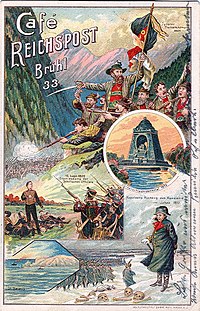Battle of Stralsund (1809)
| Battle of Stralsund | |||||||
|---|---|---|---|---|---|---|---|
| Part of Dano-Swedish War of 1808–1809 Franco-Swedish War | |||||||
 Schill's death at Stralsund, by Friedrich Hohe | |||||||
| |||||||
| Belligerents | |||||||
|
|
| ||||||
| Commanders and leaders | |||||||
|
|
| ||||||
| Strength | |||||||
|
990 Prussians 500 Swedes[1] | 5,270[2] | ||||||
| Casualties and losses | |||||||
|
300–400 killed and wounded 568 captured[2] | 241 killed and wounded[2] | ||||||
Rebellion Stralsund
The Battle of Stralsund took place on 31 May 1809 during the Dano-Swedish War of 1808–1809 and the Franco-Swedish War, part of the Napoleonic Wars, between Ferdinand von Schill's freikorps and Napoleonic forces in Stralsund. In a "vicious street battle", the freikorps was defeated and Schill was killed in action.[3]
Prelude
[edit]
Stralsund, a port at the Baltic Sea in Swedish Pomerania, was surrendered to France after the siege of 1807 during the War of the Fourth Coalition.[3] During this war, Prussian captain Ferdinand von Schill distinguished himself by cutting off French supply lines using guerrilla tactics in 1806. In 1807, he raised a freikorps and successfully fought the French forces in what he intended to become a patriotic insurrection. When his corps was disbanded after the Peace of Tilsit on 9 July 1807, Schill was promoted to the rank of a major, decorated with the Pour le Mérite, and became a hero of German resistance and patriotic movements.[4]
In January and February 1809, the German resistance in French-held Westphalia invited Schill to lead an uprising. He agreed in April and drafted a proclamation which was intercepted by the French, and left Berlin on 27 April when he was threatened with arrest.[5] With a freikorps of 100 hussars, Schill headed southwest towards Westphalia to stir up an anti-French rebellion, but news of the French victory in the Battle of Ratisbon made him change his plans. Schill turned northwards to secure a port,[6] hoping for relief by the British navy.[7]
Battle
[edit]Schill entered Stralsund on 25 May with 2,000 men.[6] The freikorps was pursued by a French-led force of 6,000 Danes, Holsteiners, Dutch and French, who confronted Schill on 31 May inside of the town.[8] By then, Schill had 1,490 troops at his command inside Stralsund, including 300 Swedes from the Rügen landwehr, as well as a militia of 200 former Swedish soldiers, under Friedrich Gustav von Petersson.[1]
The Dutch auxiliaries, about 4,000 troops, were commanded by Pierre Guillaume Gratien, another 1,500 Danish troops were under general Johann von Ewald's command.[9] Gratien's Dutch forces included the 6th and 9th infantry, 2nd Horse Regiment, two squadrons of hussars and two horse artillery batteries.[10] They entered the town after storming the Tribseer Tor gate,[11] and engaged Schill's freikorps in street fights.[7] Schill, along with 300–400 of his men, had fallen. An additional 568 men were captured, including Petersson, who was executed four days later. Between 400 and 500 men had managed to escape. The Dutch had lost 173 men, and the Danes 68.[2][8]
Aftermath
[edit]
Eleven of Schill's officers were taken to Brunswick, and later executed in Wesel[12] following an order of Napoleon Bonaparte.[3] More than five hundred of Schill's men went into captivity.[7] Schill's head was sent to The Netherlands for display in Leyden's public library, and only in 1837 the head was buried in Brunswick.[13]
Schill was not alone with his plans to stir up an insurrection of the Prussian people against the French occupation. Other prominent plotters were Frederick William, Duke of Brunswick and Kasper von Dörnberg. All of them saw the Austrian resistance and the resulting War of the Fifth Coalition as a chance to expel Napoleon Bonaparte from Northern Germany as well. France however proved to be the stronger party, and Schill's defeat in the streets of Stralsund put a definite end to all plans for a popular uprising.[14]
See also
[edit]Notes
[edit]- ^ a b Gill 2010, p. 165.
- ^ a b c d Gill 2010, p. 168.
- ^ a b c Jacques 2006, p. 973.
- ^ Clark 2006, p. 347.
- ^ Clark 2006, p. 348.
- ^ a b Parkinson 2001, p. 86.
- ^ a b c Meckenstock 2004, p. 435.
- ^ a b Parkinson 2001, p. 87.
- ^ Pelet 2009, p. 32.
- ^ Pivka & Warner 1980, p. 17.
- ^ Pelet 2009, p. 33.
- ^ Hasubek & Kreutzer 1987, p. 1118.
- ^ Clark 2006, p. 349.
- ^ Wienecke-Janz 2008, p. 142.
References
[edit]- Clark, Christopher M. (2006). Iron kingdom: the rise and downfall of Prussia, 1600–1947. Harvard University Press. ISBN 0-674-02385-4.
- Hasubek, Peter; Kreutzer, Marianne, eds. (1987). Karl Leberecht Immermann. Briefe: Textkritische und kommentierte Ausgabe in drei Bänden (in German). Vol. III. Hanser Verlag. ISBN 3-446-12446-2.
- Meckenstock, Günter (2004). Friedrich Schleiermacher. Kritische Gesamtausgabe (in German). Walter de Gruyter. ISBN 3-11-017658-0.
- Parkinson, Roger (2001). Hussar General: The Life of Blücher, Man of Waterloo. Wordsworth Editions. ISBN 1-84022-253-0.
- Pelet, Jean Jacques Germain (2009). Memoires Sur La Guerre de 1809 (in French) (reprint ed.). BiblioBazaar, LLC. ISBN 978-0-559-95080-3.
- Pivka, Otto von; Warner, Christopher (1980). Dutch-Belgian troops of the Napoleonic Wars. Osprey Publishing. ISBN 0-85045-347-X.
- Wienecke-Janz, Detlef, ed. (2008). Die große Chronik Weltgeschichte 12. Neuordnung Europas und Restauration: 1793-1849 (in German). Gütersloh/München: Wissen Media Verlag. ISBN 978-3-577-09072-8.
- Gill, Jack (2010). 1809 Thunder On The Danube: Napoleon s Defeat of the Habsburgs, Vol. III: The Final Clashes of Wagram and Znaim. London: Frontline Books. ISBN 978-1-84832-547-0.
- Jacques, Tony (2006). Dictionary of Battles And Sieges: A Guide to 8,500 Battles from Antiquity Through the Twenty-first Century. Greenwood Publishing Group. ISBN 0-313-33536-2.
External links
[edit] Media related to Battle of Stralsund (1809) at Wikimedia Commons
Media related to Battle of Stralsund (1809) at Wikimedia Commons



